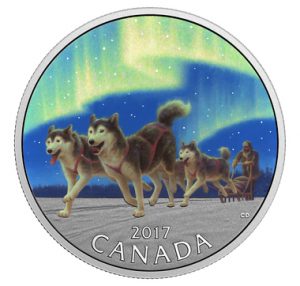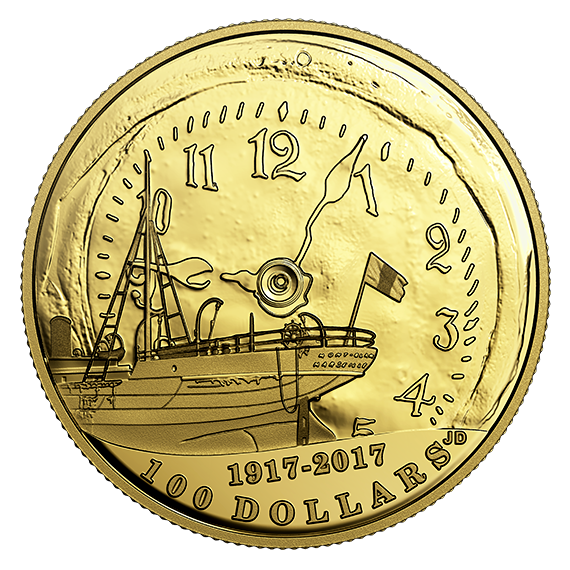Other coins issued as part of the Royal Canadian Mint’s February catalogue include a $3 Fine silver coin, “Pisces,” which is the third offering of the 12-coin Zodiac series.
The zodiac has a long, rich history dating back to Hellenic and Babylonian civilizations, when astrology and astronomy were virtually inseparable. Today, its 12 signs entertain, intrigue or inspire millions of people worldwide. The 2017 Zodiac series features Swarovski crystal embellishments within a coloured rendition of the zodiac.
The reverse design of the Pisces coin, by Pandora Young, features a clear Swarovski crystal embellishment in alignment with the traditional glyph of two fish swimming in opposite directions, which is the zodiac symbol for Pisces (Feb. 20-March 20). At the centre is a larger Swarovski crystal embellishment; its magenta colour also represents those born under the Water sign. The obverse features the effigy of Her Majesty Queen Elizabeth II by Susanna Blunt.
This 99.99 per cent pure silver coin has a mintage of 5,500 pieces; a weight of 7.96 grams; a diameter of 27 mm; a Proof finish; and serrated edges.
CELEBRATION OF LOVE
Another $3 Fine silver coin, “Celebration of Love,” was issued as part of the February catalogue.
Designed by Canadian artist Joel Kimmel, the coin’s reverse offers a celebration of love through the combination of detailed engraving, multiple finishes, selective colour and a Swarovski crystal. Two Monarch butterflies represent two souls who have found one another, with each one enhanced by the application of colour that recreates their black and orange wings. The butterflies gaze at each other from atop a heart-shaped Swarovski crystal. The crystal itself is symbolic of the nature of love, not only for its shape but also for its sparkling light effect. Both the crystal and the butterflies rise up from a large engraved coneflower (Echinacea) and are surrounded by butterfly bushes, coneflower blooms, and other butterflies in the background, including a distant Tiger swallowtail butterfly on the right.
This 99.99 per cent silver coin has a mintage of 17,500 pieces; a weight of 7.96 grams; a diameter of 27 mm; a Proof Finish; and serrated edges.
DOG SLEDDING

This $10 Fine silver coin, ‘Dog Sledding Under the Northern Lights,’ is part of a new, colourful series.
A $10 Fine silver coin, “Dog Sledding Under the Northern Lights,” was also issued this month.
Each coin in this new, colourful series is a visual celebration of a nation and its spirit through the richly varied images that bring us together “with glowing hearts.”
The reverse design, by Claudio D’Angelo, features a dog sled team riding out in the Canadian wilderness beneath the aurora borealis on a cold winter night. Nature’s silent hold on the wintry landscape is temporarily disrupted by the arrival of a dog sledding team. Working in tandem, these four harnessed dogs make their way along the path, pulling the sled and their musher behind them across the wintry landscape. Viewed from a lower vantage point that places the focus on the lead dogs, the huskies seemingly smile as they race under a starry sky. The musher is bundled up and well equipped for the journey on this clear night.
This coin has a mintage of 15,000 pieces; a weight of 15.87 grams; a diameter of 34 mm; a matte Proof finish; and serrated edges.
CANADIANA KALEIDOSCOPE

This $20 Fine silver coin, ‘Canadiana Kaleidoscope: The Loon,’ is the thinnest silver coin ever issued by the Mint.
This month also saw the release of the $20 Fine silver coin, “Canadiana Kaleidoscope: The Loon,” which is the Mint’s thinnest silver coin ever, weighing one ounce and measuring only 60 mm in diameter.
It’s the second offering of the three-coin Canadiana Kaleidoscope series, which launched last November. Tumbled glass and coloured shapes create amazing patterns inside a kaleidoscope, and this series explores the incredible designs that can be achieved when great Canadian icons become the focus of the kaleidoscope’s reflective magic.
Canadian artist Calder Moore has created a full-sized kaleidoscope design for the coin’s extra-large surface. Countless loons in myriad sizes come together in a complex pattern of amazing beauty, some face-to-face to create the outer ring of the design, while smaller birds stand rear-to-rear and upside-down to form the smaller rings towards the centre. The colours are inspired by the loon’s feathers, its red eyes, and the fiery colours of a sunset that set the stage for its hallmark call.
AIRCRAFT OF THE SECOND WORLD WAR: AVRO ANSON
Also unveiled with the February catalogue was the $20 Fine silver coin, “Avro Anson,” which is the second offering of a three-coin series featuring aircraft flown at home or abroad during the Second World War.
Nicknamed “Faithful Annie,” the Avro Anson was reputed for its stability and rugged reliability. Its wartime production fuelled Canada’s aircraft manufacturing industry, but its most significant role was arguably as the twin-engine aircraft of the British Commonwealth Air Training Plan.
The reverse design, by Canadian artist David Oram, features an engraved depiction of an Avro Anson in one of its many roles during the war. Selective colour recreates the dark green and brown camouflage colours of the Anson, whose gun remains trained on the Messerschmitt BF 110 in the background. The obverse features the effigy of King George VI by T.H. Paget.
This coin has a mintage of 7,500 pieces; a weight of 31.83 grams; a diameter of 40 mm; a Proof finish; and serrated edges.
HALIFAX EXPLOSION
Rounding out the February releases is the 14-karat $100 gold coin, “100th Anniversary of the Halifax Explosion.”
It was the largest man-made explosion of the pre-nuclear era. On the morning of Dec. 6, 1917, the Norwegian ship SS Imo and the French munitions ship SS Mont-Blanc collided as they made their way through Halifax’s busy harbour. The impact ignited Mont-Blanc’s explosive cargo, resulting in an explosive blast that instantly levelled an entire district and triggered a tsunami.
This 14-karat gold coin commemorates the 100th anniversary of the Halifax Explosion of 1917 through two powerfully symbolic elements that are associated with this maritime disaster, which remains one of the worst Canadian tragedies of all time.
The reverse design, by Canadian artist Jamie Desrochers, recreates two symbolic elements synonymous with the Halifax Explosion: SS Mont-Blanc, whose cargo was the source of the tragic explosion, and an explosion-damaged clock that was retrieved from the rubble. In the foreground is a partial portside view of the Mont-Blanc’s stern, which was struck by the Imo on the morning of Dec. 6. In the background, multiple finishes enhance the engraved clock’s appearance while conveying the extent of the damage: the metal is beaten, warped and twisted; its face, hands and numbers have melted from the intense heat, yet they retained their form. The clock stands as a permanent reminder if a moment frozen in time, its hands forever marking the moment of the explosion: 9:04 a.m.
This coin has a mintage of 1,500 pieces; a weight of 12 grams; and a diameter of 27 mm.
For more information, visit mint.ca.




